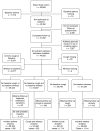Ambient air pollution exposure and incident adult asthma in a nationwide cohort of U.S. women
- PMID: 25172226
- PMCID: PMC4299575
- DOI: 10.1164/rccm.201403-0525OC
Ambient air pollution exposure and incident adult asthma in a nationwide cohort of U.S. women
Abstract
Rationale: Limited prior data suggest an association between traffic-related air pollution and incident asthma in adults. No published studies assess the effect of long-term exposures to particulate matter less than 2.5 μm in diameter (PM2.5) on adult incident asthma.
Objectives: To estimate the association between ambient air pollution exposures (PM2.5 and nitrogen dioxide, NO2) and development of asthma and incident respiratory symptoms.
Methods: The Sister Study is a U.S. cohort study of risk factors for breast cancer and other health outcomes (n = 50,884) in sisters of women with breast cancer (enrollment, 2003-2009). Annual average (2006) ambient PM2.5 and NO2 concentrations were estimated at participants' addresses, using a national land-use/kriging model incorporating roadway information. Outcomes at follow-up (2008-2012) included incident self-reported wheeze, chronic cough, and doctor-diagnosed asthma in women without baseline symptoms.
Measurements and main results: Adjusted analyses included 254 incident cases of asthma, 1,023 of wheeze, and 1,559 of chronic cough. For an interquartile range (IQR) difference (3.6 μg/m(3)) in estimated PM2.5 exposure, the adjusted odds ratio (aOR) was 1.20 (95% confidence interval [CI] = 0.99-1.46, P = 0.063) for incident asthma and 1.14 (95% CI = 1.04-1.26, P = 0.008) for incident wheeze. For NO2, there was evidence for an association with incident wheeze (aOR = 1.08, 95% CI = 1.00-1.17, P = 0.048 per IQR of 5.8 ppb). Neither pollutant was significantly associated with incident cough (PM2.5: aOR = 0.95, 95% CI = 0.88-1.03, P = 0.194; NO2: aOR = 1.00, 95% CI = 0.93-1.07, P = 0.939).
Conclusions: Results suggest that PM2.5 exposure increases the risk of developing asthma and that PM2.5 and NO2 increase the risk of developing wheeze, the cardinal symptom of asthma, in adult women.
Keywords: NO2; PM2.5; asthma incidence; nitrogen dioxide; particulate matter.
Figures



References
-
- Jacquemin B, Schikowski T, Carsin AE, Hansell A, Krämer U, Sunyer J, Probst-Hensch N, Kauffmann F, Künzli N. The role of air pollution in adult-onset asthma: a review of the current evidence. Semin Respir Crit Care Med. 2012;33:606–619. - PubMed
-
- Health Effects Institute (HEI) Panel on the Health Effects of Traffic-Related Air Pollution. Boston: Health Effects Institute; 2010. Traffic-related air pollution: a critical review of the literature on emissions, exposure, and health effects.
-
- Künzli N, Bridevaux P-O, Liu L-JS, Garcia-Esteban R, Schindler C, Gerbase MW, Sunyer J, Keidel D, Rochat T Swiss Cohort Study on Air Pollution and Lung Diseases in Adults. Traffic-related air pollution correlates with adult-onset asthma among never-smokers. Thorax. 2009;64:664–670. - PubMed
-
- McDonnell WF, Abbey DE, Nishino N, Lebowitz MD. Long-term ambient ozone concentration and the incidence of asthma in nonsmoking adults: the AHSMOG Study. Environ Res. 1999;80:110–121. - PubMed
-
- Brunekreef B, Holgate ST. Air pollution and health. Lancet. 2002;360:1233–1242. - PubMed
Publication types
MeSH terms
Substances
Grants and funding
LinkOut - more resources
Full Text Sources
Other Literature Sources
Medical

